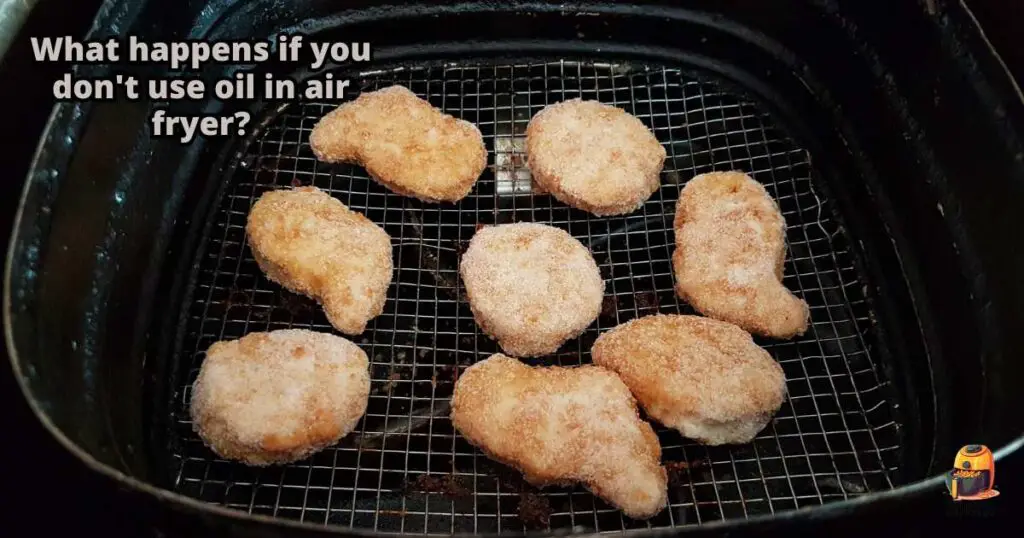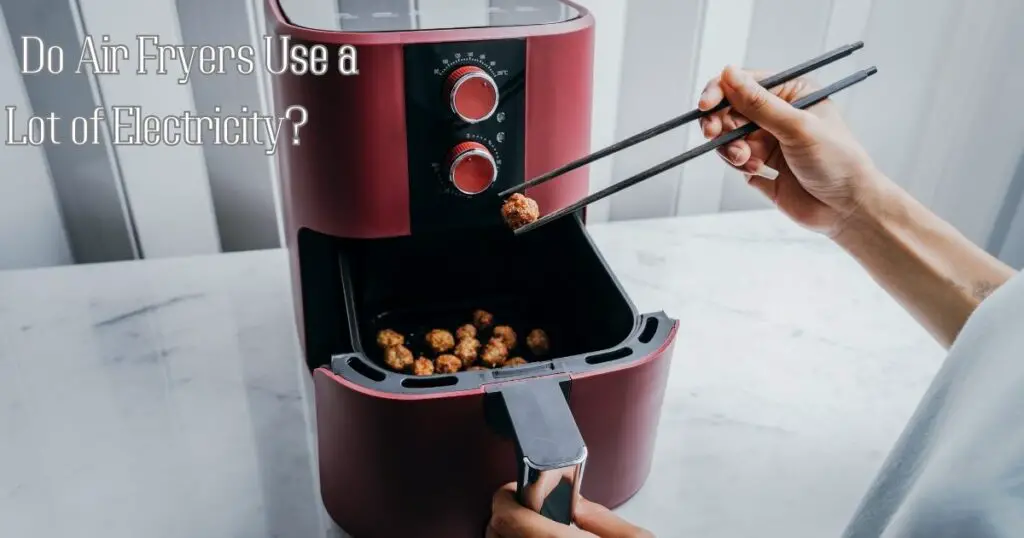Table Of Contents
When you opt to cook without oil in an air fryer, your food may lack the desired crispiness and the golden-brown hue typically associated with frying. This is because oil plays a crucial role in browning and achieving that crispy texture. However, it’s worth noting that this approach results in healthier, lower-calorie dishes.
Some foods, particularly those with inherent moisture or natural fats, can still turn out well without oil. To mitigate the absence of oil, consider preheating your air fryer and using alternatives like parchment paper or non-stick sprays to prevent sticking.
Additionally, flavor enhancement can be achieved through the use of herbs, spices, and flavorful marinades.
What Happens if You Don’t Use Oil in Air Fryer

When you choose not to use oil in an air fryer, several things can occur:
Texture and Crispiness
The absence of oil in your air frying endeavors means that achieving the same level of crispiness and crunch you associate with deep-frying or conventional oil-fried foods may become more challenging. Oil plays a pivotal role in the creation of that highly desirable, crispy exterior that is often the hallmark of fried dishes. Without it, the textures are somewhat different, with less crunch and a tendency toward drier surfaces.
Color and Appearance
The visual appeal of your dishes can be significantly impacted when oil is omitted from the cooking process. The browning of foods in an air fryer results from the Maillard reaction, and oil is instrumental in facilitating this process.
This can mean that achieving that appealing golden-brown color so commonly associated with frying may prove more elusive when you opt not to use oil.
Flavor Profile
Oil does more than contribute to the texture and appearance of your culinary creations; it also carries and enhances flavors. When you cook without oil, your dishes may lack the same depth and richness of taste you’re accustomed to in traditionally fried or oil-assisted preparations.
This flavor difference can sometimes leave dishes tasting somewhat less savory, and it becomes crucial to compensate for this by being more intentional with other flavor-enhancing ingredients, such as herbs, spices, and marinades.
Sticking Issues
The use of oil in air frying serves not only for its cooking properties but also as a natural non-stick agent. When you omit oil, foods are more likely to adhere to the air fryer basket or tray, leading to challenges when it comes to removing the items intact.
Sticking issues can result in the loss of texture and presentation, potentially affecting the overall appeal of the dish.
Dryness
Foods cooked without oil are inherently more prone to dryness, as oil plays a significant role in retaining moisture during the cooking process. This is particularly noticeable in meats and baked goods, which may turn out to be less juicy and tender compared to when oil is included.
To combat dryness, alternative methods such as brines, marinades, or sauces can be used to reintroduce moisture and flavor into your dishes.
Longer Cooking Times
The absence of oil can affect the overall cooking process, often requiring slightly longer cooking times to reach the desired texture and level of doneness. This necessitates careful adjustments to your cooking times and closer monitoring of the process to ensure your food reaches the desired quality.
Difficulty with Certain Foods
While many foods can be successfully air-fried without oil, some delicate or thinly coated items may not fare as well. Foods like tempura or certain desserts that depend on oil for both texture and browning may not achieve the expected results when oil is omitted from the equation.
Seasoning Importance
When you choose not to use oil in your air fryer, the importance of seasoning and marinating your food becomes even more critical. Utilizing flavorful herbs, spices, and marinades is key to compensating for the absence of oil. These seasonings not only enhance the taste of your dishes but also make them more visually appealing.
Staining and Cleaning
Foods with vibrant colors or robust flavors, such as curries or heavily seasoned dishes, have the potential to cause staining in the air fryer basket or tray. As a result, you may need to engage in more rigorous and meticulous cleaning after each use to prevent lingering odors and unsightly stains.
Recipe Adaptation
To successfully air fry without oil, you may need to adjust your recipes and cooking techniques. Experimentation is essential to find the right balance and achieve the desired results.
Health Considerations
The decision to use less or no oil in air frying is often driven by health-conscious choices. While this approach reduces the overall calorie and fat content of your dishes, it can impact the taste and texture of your food. It’s a trade-off between health and culinary preferences.
How Do Air Fryers Work Without Oil?
Air fryers achieve oil-free cooking by utilizing a combination of advanced cooking techniques, primarily through hot air circulation and convection. Here’s an in-depth explanation of how they work without the need for oil:
Hot Air Circulation
The core component of an air fryer is a heating element positioned above the cooking chamber. When you set the desired temperature on the appliance, this heating element generates intense heat. This heat source is responsible for providing the energy needed to cook the food.
Convection
Convection is the fundamental principle behind air frying without oil. Air fryers are equipped with a powerful fan located just above the heating element. As the heating element warms the air, the fan rapidly circulates this hot air throughout the cooking chamber. The hot air moves at high speed, enveloping the food from all angles.
Cooking Process
As the hot air engulfs the food, it cooks the ingredients uniformly and efficiently. This circulating hot air works much like the oil in traditional frying, promoting the Maillard reaction, which is responsible for browning and crisping the food’s exterior. This results in a desirable crispy texture that is often associated with fried dishes.
Food Preparation
To optimize cooking without oil, it’s essential to prepare the food properly. While you can cook without oil, some users prefer lightly coating the food with a small amount of oil or using a cooking spray. This minimal use of oil can enhance browning, flavor, and the overall appeal of the dish. However, it’s worth noting that this added oil is optional and not a strict requirement for air frying.
How Do I Prevent Sticking When Air Frying Without Oil?
Preventing sticking in an air fryer when cooking without oil is possible with a few tips and techniques. Here’s how to ensure your food doesn’t adhere to the basket or tray:
Preheat Your Air Fryer
Just like with traditional ovens, preheating your air fryer for a few minutes helps create a non-stick surface. It ensures the cooking chamber is at the right temperature when you start cooking.
Utilize Parchment Paper
Use parchment paper to line the tray or basket of the air fryer. Cut it to size, leaving room for proper air circulation. Parchment paper is an excellent non-stick option that makes food removal a breeze.
Invest in a Quality Cooking Spray
Purchase a high-quality cooking spray or invest in an oil mister. Lightly spray or mist the food with a thin, even layer before placing it in the air fryer. This not only prevents sticking but also enhances browning.
Non-Stick Accessories
Some air fryers come with non-stick accessories like silicone mats or non-stick baking pans. Utilize these accessories to avoid sticking and simplify cleanup.
Prevent Overcrowding
Avoid overloading the air fryer basket or tray. Overcrowding can lead to uneven cooking and food sticking together. Ensure there’s ample space between items for proper hot air circulation.
Flip or Shake as Needed
Periodically flip or shake the food during the cooking process. This action helps ensure even cooking and prevents food from adhering to the cooking surface. You can set a timer to remind you when it’s time to flip or shake.
Consider Coatings
When air frying items like chicken tenders or fish, consider coating them with breadcrumbs or a light breading. These coatings create a protective layer, reducing the chances of sticking.
Avoid Wet Batters
Foods with wet batters, such as tempura, can be challenging to air fry without sticking. Opt for drier coatings or, if you prefer a wet batter, consider giving it a light spritz of cooking spray before air frying.
Adjust Temperature Carefully
Be mindful of the cooking temperature. Higher temperatures can cause food to stick more easily. Adjust the temperature as needed for the specific dish you’re preparing, and find the right balance between crispiness and sticking prevention.
Regular Cleaning and Maintenance
A well-maintained air fryer is less likely to have sticking issues. Clean the cooking surfaces, basket, and tray after each use to prevent residue buildup that could lead to sticking.
Alternative Ways to Enhance Flavor While Air Frying Without Oil
Enhancing the flavor of air-fried dishes without using oil opens up a world of creative and healthy culinary possibilities. Here’s a more detailed exploration of each alternative method:
- Seasoning
Seasoning forms the foundation of flavor enhancement. Using herbs, spices, salt, and pepper allows you to create myriad taste combinations, giving depth and character to your dishes. Experiment with various blends to achieve unique and delightful flavor profiles.
- Marinades
Marinating ingredients before air frying is a transformative technique. It infuses food with rich and complex flavors. You can concoct marinades using ingredients like vinegar, citrus, soy sauce, herbs, and spices to create delicious and aromatic blends that elevate your dishes.
- Citrus Zest
The zest of citrus fruits such as lemons, limes, and oranges provides a burst of brightness and tanginess. Grate the zest over your dishes to impart a zesty and refreshing flavor, enhancing the overall taste.
- Aromatics
Aromatics like garlic, onions, ginger, and shallots are flavor powerhouses. Sautéing these ingredients briefly before air frying releases their aromatic depths, infusing your dishes with robust and enticing flavors.
- Broths and Stocks
Adding a small amount of flavorful broth or stock to the air fryer pan serves two purposes. It keeps the food moist during cooking and imparts a savory depth to your dishes. This technique is particularly effective for proteins and vegetables.
- Condiments
Condiments like mustard, soy sauce, Worcestershire sauce, and hot sauces are quick flavor boosters. They add depth and complexity to your dishes without contributing excessive volume, creating a flavor-rich culinary experience.
- Umami Ingredients
Ingredients rich in umami, such as soy sauce, miso paste, or tomato paste, intensify the savory dimension of your dishes. Umami adds a layer of depth and complexity, making the meal more satisfying.
- Fresh Herbs
Fresh herbs like basil, cilantro, rosemary, and thyme provide a finishing touch to your dishes. Sprinkle them over the cooked food to enhance both taste and presentation, adding a burst of freshness and flavor.
- Nuts and Seeds
Toasted nuts and seeds contribute crunch and a subtle nutty taste to your dishes. Crushing and using them as a flavorful topping enhances texture and introduces a layer of richness.
- Cheese
For a delightful burst of rich and savory flavor, consider adding a sprinkle of grated Parmesan, Pecorino, or nutritional yeast to your dishes after air frying. Cheese introduces a creamy and indulgent dimension.
- Infused Oils
If you prefer a milder use of oil, consider infusing it with herbs or garlic. Drizzle this oil sparingly over your dishes after cooking to add a subtle hint of flavor without introducing excessive oil content.
Tips for Oil Free Air Frying
Achieving oil-free air frying that’s both successful and satisfying requires attention to detail and some tried-and-true techniques. Here’s a more comprehensive guide to mastering oil-free air frying:
- A high-quality air fryer with precise temperature control and even heat distribution is crucial. It ensures that your food is cooked evenly and reaches the desired level of crispiness without needing excess oil.
- Consider using non-stick air fryer baskets or accessories. These prevent food from sticking to the cooking surface, making cleanup easier and promoting oil-free cooking.
- Just like with a traditional oven, preheating your air fryer for a few minutes before cooking is beneficial. This prepares the cooking chamber for your food and helps achieve a crispier texture, similar to deep frying.
- Ensure that your ingredients are dry before placing them in the air fryer. Excess moisture can hinder the crisping process. Use paper towels to pat your food dry if necessary.
- Don’t be afraid to experiment with different cooking temperatures. Higher temperatures often lead to crisper results, but it’s important to find the right temperature for each dish.
- Season your food generously with herbs, spices, and flavorings. Since you’re not using oil, seasoning becomes even more important to enhance taste and make up for the lack of oil’s flavor.
- For meats and vegetables, consider marinating them before air frying. Marinating infuses your ingredients with rich flavors, compensating for the absence of oil.
- While the goal is to be oil-free, if you find that food is sticking to the basket, a light spritz of cooking spray can be used sparingly to prevent sticking.
- Avoid overcrowding the air fryer basket. When food items overlap or are overcrowded, it can obstruct air circulation and result in uneven cooking.
- Periodically flip or shake the food in the basket during the cooking process. This ensures even cooking on all sides and helps achieve uniform crispiness.
- To prevent sticking and make cleanup easier, consider using parchment paper or silicone baking mats in the air fryer basket.
- Pay close attention to cooking times. Oil-free air frying can be faster than traditional cooking methods, so monitor your food to avoid overcooking.
- Oil-free air frying may require some experimentation to achieve the ideal texture and taste. Be patient and willing to adjust your techniques to suit your preferences.
- Certain foods work better for oil-free air frying than others. Foods with a natural fat content, such as chicken thighs or salmon, tend to crisp up well without additional oil.
- Explore the versatility of your air fryer by cooking a variety of dishes. From crispy veggies and juicy meats to desserts like apple chips, an air fryer can handle a wide range of recipes.
- Frequently clean your air fryer to maintain it. A clean air fryer ensures proper air circulation and minimizes lingering odors from previous cooking sessions.
Read More:
FAQs
What Foods Should I Not Use Oil for?
For most meats, excluding frozen ones, oil isn’t necessary for the air fryer. The general guideline is that if the food requires oil when cooking in the oven, you should use a small amount in the air fryer. This also applies to spraying a baking sheet to prevent sticking.
Can You Use an Air Fryer Without Oil?
Yes, you can use an air fryer without oil. While some recipes recommend a small amount of oil, it’s not essential. The appliance’s high heat and circulating air can achieve a crispy texture without any added oil, making it ideal for oil-free cooking.
What Foods Need Oil to Cook in an Air Fryer?
Certain foods cooked in an air fryer benefit from the use of oil. For bread like chicken tenders or coconut shrimp, a 1 tsp oil spray ensures even browning and moisture retention. For vegetables like asparagus, tossing them with a little oil before air frying is convenient. When roasting diced potatoes or sweet potatoes, use 1-2 TBSP of oil for even coating. Omitting oil can lead to dry or tough results, but air frying remains a healthier alternative to deep frying.
How Much Oil Do You Use in an Air Fryer?
The amount of oil you use in an air fryer depends on the recipe’s guidance. Typically, you can start with a tablespoon of oil and adjust as needed for crispiness and flavor. If you’re using an oil sprayer, a few spritzes are usually sufficient.
Can You Fry Egg Without Oil?
Yes, you can fry eggs without oil. To do so, place a non-stick pan on the stove and allow it to heat up. Add a small amount of water to the pan and cover it with a lid to cook the eggs.
Can I Substitute Butter for Oil?
Yes, you can substitute butter for oil in a 1:1 ratio. This substitution works well with various oils like olive, canola, vegetable, and coconut. Just melt the butter, allow it to cool to room temperature, and proceed with your recipe as usual. For instance, if the recipe requires ½ cup of oil, use ½ cup of melted and cooled butter.
Final Verdict
In conclusion, air frying without oil is entirely possible and offers both advantages and challenges. It results in healthier, lower-calorie dishes, with some foods still turning out well. However, there are trade-offs, such as potential issues with texture, color, and flavor.
Proper techniques, seasoning, and understanding which foods benefit from a touch of oil are key.
An air fryer can produce crispy and delicious results without excess oil, making it a healthier alternative to deep frying. Mastering oil-free air frying takes practice, but the results are worth it.
You May Also Like to Read:


